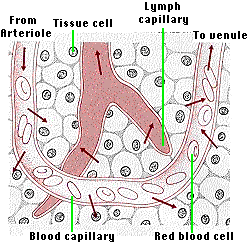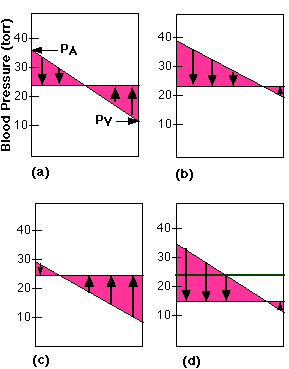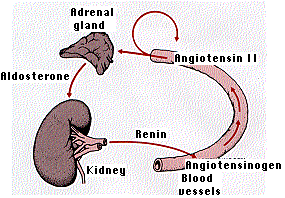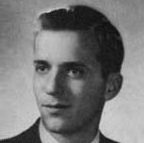15.3B: How the Human Circulatory System Works
- Page ID
- 5395
\( \newcommand{\vecs}[1]{\overset { \scriptstyle \rightharpoonup} {\mathbf{#1}} } \)
\( \newcommand{\vecd}[1]{\overset{-\!-\!\rightharpoonup}{\vphantom{a}\smash {#1}}} \)
\( \newcommand{\id}{\mathrm{id}}\) \( \newcommand{\Span}{\mathrm{span}}\)
( \newcommand{\kernel}{\mathrm{null}\,}\) \( \newcommand{\range}{\mathrm{range}\,}\)
\( \newcommand{\RealPart}{\mathrm{Re}}\) \( \newcommand{\ImaginaryPart}{\mathrm{Im}}\)
\( \newcommand{\Argument}{\mathrm{Arg}}\) \( \newcommand{\norm}[1]{\| #1 \|}\)
\( \newcommand{\inner}[2]{\langle #1, #2 \rangle}\)
\( \newcommand{\Span}{\mathrm{span}}\)
\( \newcommand{\id}{\mathrm{id}}\)
\( \newcommand{\Span}{\mathrm{span}}\)
\( \newcommand{\kernel}{\mathrm{null}\,}\)
\( \newcommand{\range}{\mathrm{range}\,}\)
\( \newcommand{\RealPart}{\mathrm{Re}}\)
\( \newcommand{\ImaginaryPart}{\mathrm{Im}}\)
\( \newcommand{\Argument}{\mathrm{Arg}}\)
\( \newcommand{\norm}[1]{\| #1 \|}\)
\( \newcommand{\inner}[2]{\langle #1, #2 \rangle}\)
\( \newcommand{\Span}{\mathrm{span}}\) \( \newcommand{\AA}{\unicode[.8,0]{x212B}}\)
\( \newcommand{\vectorA}[1]{\vec{#1}} % arrow\)
\( \newcommand{\vectorAt}[1]{\vec{\text{#1}}} % arrow\)
\( \newcommand{\vectorB}[1]{\overset { \scriptstyle \rightharpoonup} {\mathbf{#1}} } \)
\( \newcommand{\vectorC}[1]{\textbf{#1}} \)
\( \newcommand{\vectorD}[1]{\overrightarrow{#1}} \)
\( \newcommand{\vectorDt}[1]{\overrightarrow{\text{#1}}} \)
\( \newcommand{\vectE}[1]{\overset{-\!-\!\rightharpoonup}{\vphantom{a}\smash{\mathbf {#1}}}} \)
\( \newcommand{\vecs}[1]{\overset { \scriptstyle \rightharpoonup} {\mathbf{#1}} } \)
\( \newcommand{\vecd}[1]{\overset{-\!-\!\rightharpoonup}{\vphantom{a}\smash {#1}}} \)
\(\newcommand{\avec}{\mathbf a}\) \(\newcommand{\bvec}{\mathbf b}\) \(\newcommand{\cvec}{\mathbf c}\) \(\newcommand{\dvec}{\mathbf d}\) \(\newcommand{\dtil}{\widetilde{\mathbf d}}\) \(\newcommand{\evec}{\mathbf e}\) \(\newcommand{\fvec}{\mathbf f}\) \(\newcommand{\nvec}{\mathbf n}\) \(\newcommand{\pvec}{\mathbf p}\) \(\newcommand{\qvec}{\mathbf q}\) \(\newcommand{\svec}{\mathbf s}\) \(\newcommand{\tvec}{\mathbf t}\) \(\newcommand{\uvec}{\mathbf u}\) \(\newcommand{\vvec}{\mathbf v}\) \(\newcommand{\wvec}{\mathbf w}\) \(\newcommand{\xvec}{\mathbf x}\) \(\newcommand{\yvec}{\mathbf y}\) \(\newcommand{\zvec}{\mathbf z}\) \(\newcommand{\rvec}{\mathbf r}\) \(\newcommand{\mvec}{\mathbf m}\) \(\newcommand{\zerovec}{\mathbf 0}\) \(\newcommand{\onevec}{\mathbf 1}\) \(\newcommand{\real}{\mathbb R}\) \(\newcommand{\twovec}[2]{\left[\begin{array}{r}#1 \\ #2 \end{array}\right]}\) \(\newcommand{\ctwovec}[2]{\left[\begin{array}{c}#1 \\ #2 \end{array}\right]}\) \(\newcommand{\threevec}[3]{\left[\begin{array}{r}#1 \\ #2 \\ #3 \end{array}\right]}\) \(\newcommand{\cthreevec}[3]{\left[\begin{array}{c}#1 \\ #2 \\ #3 \end{array}\right]}\) \(\newcommand{\fourvec}[4]{\left[\begin{array}{r}#1 \\ #2 \\ #3 \\ #4 \end{array}\right]}\) \(\newcommand{\cfourvec}[4]{\left[\begin{array}{c}#1 \\ #2 \\ #3 \\ #4 \end{array}\right]}\) \(\newcommand{\fivevec}[5]{\left[\begin{array}{r}#1 \\ #2 \\ #3 \\ #4 \\ #5 \\ \end{array}\right]}\) \(\newcommand{\cfivevec}[5]{\left[\begin{array}{c}#1 \\ #2 \\ #3 \\ #4 \\ #5 \\ \end{array}\right]}\) \(\newcommand{\mattwo}[4]{\left[\begin{array}{rr}#1 \amp #2 \\ #3 \amp #4 \\ \end{array}\right]}\) \(\newcommand{\laspan}[1]{\text{Span}\{#1\}}\) \(\newcommand{\bcal}{\cal B}\) \(\newcommand{\ccal}{\cal C}\) \(\newcommand{\scal}{\cal S}\) \(\newcommand{\wcal}{\cal W}\) \(\newcommand{\ecal}{\cal E}\) \(\newcommand{\coords}[2]{\left\{#1\right\}_{#2}}\) \(\newcommand{\gray}[1]{\color{gray}{#1}}\) \(\newcommand{\lgray}[1]{\color{lightgray}{#1}}\) \(\newcommand{\rank}{\operatorname{rank}}\) \(\newcommand{\row}{\text{Row}}\) \(\newcommand{\col}{\text{Col}}\) \(\renewcommand{\row}{\text{Row}}\) \(\newcommand{\nul}{\text{Nul}}\) \(\newcommand{\var}{\text{Var}}\) \(\newcommand{\corr}{\text{corr}}\) \(\newcommand{\len}[1]{\left|#1\right|}\) \(\newcommand{\bbar}{\overline{\bvec}}\) \(\newcommand{\bhat}{\widehat{\bvec}}\) \(\newcommand{\bperp}{\bvec^\perp}\) \(\newcommand{\xhat}{\widehat{\xvec}}\) \(\newcommand{\vhat}{\widehat{\vvec}}\) \(\newcommand{\uhat}{\widehat{\uvec}}\) \(\newcommand{\what}{\widehat{\wvec}}\) \(\newcommand{\Sighat}{\widehat{\Sigma}}\) \(\newcommand{\lt}{<}\) \(\newcommand{\gt}{>}\) \(\newcommand{\amp}{&}\) \(\definecolor{fillinmathshade}{gray}{0.9}\)All the functions of the circulatory system occur in the capillary beds. The rest of the system consists of two pumps (in the heart) and associated plumbing:
- arteries and their terminal branches, the arterioles
- veins and their tributaries, the venules.
Blood Pressure
Blood moves through the arteries, arterioles, and capillaries because of the force created by the contraction of the ventricles.
Blood pressure in the arteries.
The surge of blood that occurs at each contraction is transmitted through the elastic walls of the entire arterial system where it can be detected as the pulse. Even during the brief interval when the heart is relaxed — called diastole — there is still pressure in the arteries. When the heart contracts — called systole — the pressure increases.
Blood pressure is expressed as two numbers, e.g., 120/80. The first is the pressure during systole. The unit of measure is the torr, in this example, the pressure equivalent to that produced by a column of mercury 120 mm high. The second number is the pressure at diastole.
Although blood pressure can vary greatly in an individual, continual high pressure — especially diastolic pressure — may be the symptom or cause of a variety of ailments. The medical term for high blood pressure is hypertension.
Blood pressure in the capillaries
The pressure of arterial blood is largely dissipated when the blood enters the capillaries. Capillaries are tiny vessels with a diameter just about that of a red blood cell (7.5 µm). Although the diameter of a single capillary is quite small, the number of capillaries supplied by a single arteriole is so great that the total cross-sectional area available for the flow of blood is increased. Therefore, the pressure of the blood as it enters the capillaries decreases.
Blood pressure in the veins
When blood leaves the capillaries and enters the venules and veins, little pressure remains to force it along. Blood in the veins below the heart is helped back up to the heart by the muscle pump. This is simply the squeezing effect of contracting muscles on the veins running through them. One-way flow to the heart is achieved by valves within the veins.
Exchanges Between Blood and Cells

With rare exceptions, our blood does not come into direct contact with the cells it nourishes. As blood enters the capillaries surrounding a tissue space, a large fraction of it is filtered into the tissue space. It is this interstitial or extracellular fluid (ECF) that brings to cells all of their requirements and takes away their products. The number and distribution of capillaries is such that probably no cell is ever farther away than 50 µm from a capillary.
When blood enters the arteriole end of a capillary, it is still under pressure (about 35 torr) produced by the contraction of the ventricle. As a result of this pressure, a substantial amount of water and some plasma proteins filter through the walls of the capillaries into the tissue space. Thus fluid, called interstitial fluid, is simply blood plasma minus most of the proteins. It has the same composition and is formed in the same way as the nephric filtrate in kidneys. Interstitial fluid bathes the cells in the tissue space and substances in it can enter the cells by diffusion or active transport. Substances, like carbon dioxide, can diffuse out of cells and into the interstitial fluid.
Near the venous end of a capillary, the blood pressure is greatly reduced (to about 15 torr). Here another force comes into play. Although the composition of interstitial fluid is similar to that of blood plasma, it contains a smaller concentration of proteins than plasma and thus a somewhat greater concentration of water. This difference sets up an osmotic pressure. Although the osmotic pressure is small (~ 25 torr), it is greater than the blood pressure at the venous end of the capillary. Consequently, the fluid reenters the capillary here.
The first of the four graphs (a) shows this balanced relationship in the capillary bed; the others show what happens when the system is altered.

Pressure relations in the capillaries.
PA = blood pressure at the arteriole end of the capillary.
PV = blood pressure at the venule end of the capillary.
The horizontal line represents the osmotic pressure of the blood.
When the blood pressure is greater than the osmotic pressure, filtration of interstitial fluid occurs (downward-pointing arrows).
When the blood pressure is less than the osmotic pressure, reabsorption of interstitial fluid occurs (up arrows).
(a) The normal situation. Filtration and absorption are balance.
(b) Result of dilating the arterioles. PA increases and the tissue space becomes engorged with interstitial fluid.
(c) Result of constricting the arterioles. PA decreases and interstitial fluid is withdrawn from the tissue space.
(d) Result of a lowered concentration of protein in the blood (such as occurs during prolonged malnutrition). Because of the reduced osmotic pressure (lower horizontal line), fluid accumulates in the tissue spaces resulting in edema.
Control of the Capillary Beds
An adult human has been estimated to have some 60,000 miles (96,560 km) of capillaries with a total surface area of some 800–1000 m2 (an area greater than three tennis courts). The total volume of this system is roughly 5 liters, the same as the total volume of blood. However, if the heart and major vessels are to be kept filled, all the capillaries cannot be filled at once. So a continual redirection of blood from organ to organ takes place in response to the changing needs of the body. During vigorous exercise, for example, capillary beds in the skeletal muscles open at the expense of those in the viscera. The reverse occurs after a heavy meal.
The table shows the distribution of blood in the human body at rest and during vigorous exercise. Note the increase in blood supply to the working organs (skeletal muscles and heart). The increased blood supply to the skin aids in the dissipation of the heat produced by the muscles. Note also that the blood supply to the brain remains constant. The total blood flow during exercise increases because of a more rapid heartbeat and also a greater volume of blood pumped at each beat.
| Blood Flow ml/min | ||
| At Rest | During Strenuous Exercise |
|
| Heart | 250 | 750 |
| Kidneys | 1,200 | 600 |
| Skeletal Muscles | 1,000 | 12,5000 |
| Skin | 400 | 1,900 |
| Viscera | 1,400 | 600 |
| Brain | 750 | 750 |
| Other | 600 | 400 |
| Total | 5,600 | 17,500 |
The walls of arterioles are encased in smooth muscle. Constriction of arterioles decreases blood flow into the capillary beds they supply while dilation has the opposite effect. In time of danger or other stress, for example, the arterioles supplying the skeletal muscles will be dilated while the bore of those supplying the digestive organs will decrease. These actions are carried out by
- the autonomic nervous system
- local controls in the capillary beds
Local Control in the Capillary Beds
- Nitric oxide (NO) is a potent dilator of arteries and arterioles.
- When the endothelial cells that line these vessels are stimulated, they synthesize nitric oxide. It quickly diffuses into the muscular walls of the vessels causing them to relax.
- In addition, as the hemoglobin in red blood cells releases its O2 in actively-respiring tissues, the lowered pH causes it to also release NO which helps dilate the vessels to meet the increased need of the tissue.
Nitroglycerine, which is often prescribed to reduce the pain of angina, does so by generating nitric oxide, which relaxes the walls of the arteries and arterioles. The prescription drug sildenafil citrate ("Viagra") does the same for vessels supplying blood to the penis. The effects of these two drugs are additive and using them together could precipitate a dangerous drop in blood pressure.
- Cells where infection or other damage is occurring release substances like histamine that dilate the arterioles and thus increase blood flow in the area.
- In most of the body, the flow of blood through a capillary is controlled by the arteriole supplying it. In the brain, however, another mechanism participates. The degree of contraction of pericytes, cells that surround the capillary, also adjusts the flow of blood through the capillary. The changes in brain activity seen by such imaging procedures as fMRI and PET scans are probably influenced by pericyte activity.
Shock
Under some circumstances, capillary beds may open without others closing in compensation. Although the volume of blood remains unchanged, blood pressure declines abruptly as blood pools in the capillary beds. If untreated shock is usually fatal.
Shock can also result from severe bleeding. The heart can only pump as much blood as it receives. If insufficient blood gets back to the heart, its output — and hence blood pressure — drops. The tissues fail to receive enough oxygen. This is especially critical for the brain and the heart itself. To cope with the problem, arterioles constrict and shut down the capillary beds — except those in the brain and heart. This reduces the volume of the system and helps maintain normal blood pressure.
Air-breathing vertebrates that spend long periods under water (e.g., seals, penguins, turtles, and alligators) employ a similar mechanism to ensure that the oxygen supply of the heart and brain is not seriously diminished. When the animal dives, the blood supply to the rest of the body is sharply reduced so that what oxygen remains will be available for those organs needing it most: the brain and heart.
Regulation of Blood Pressure by Hormones

One of the functions of the kidney is to monitor blood pressure and take corrective action if it should drop. The kidney does this by secreting the protease renin.
- Renin acts on angiotensinogen, a plasma peptide, splitting off a fragment containing 10 amino acids called angiotensin I.
- angiotensin I is cleaved by a peptidase secreted by blood vessels called angiotensin converting enzyme (ACE) producing angiotensin II, which contains 8 amino acids.
- angiotensin II
- constricts the walls of arterioles closing down capillary beds
- stimulates the proximal tubules in the kidney to reabsorb sodium ions
- stimulates the adrenal cortex to release aldosterone. Aldosterone causes the kidneys to reclaim still more sodium and thus water
- increases the strength of the heartbeat
- stimulates the pituitary to release the vasopressin
The Heart
A rise in blood pressure stretches the atria of the heart. This triggers the release of atrial natriuretic peptide (ANP). ANP is a peptide of 28 amino acids. ANP lowers blood pressure by:
- relaxing arterioles
- inhibiting the secretion of renin and aldosterone
- inhibiting the reabsorption of sodium ions in the collecting ducts of the kidneys
The effects on the kidney reduce the reabsorption of water by them thus increasing the flow of urine and the amount of sodium excreted in it (These actions give ANP its name: natrium = sodium; uresis = urinate). The net effect of these actions is to reduce blood pressure by reducing the volume of blood volume in the system.
Contributors and Attributions
John W. Kimball. This content is distributed under a Creative Commons Attribution 3.0 Unported (CC BY 3.0) license and made possible by funding from The Saylor Foundation.


